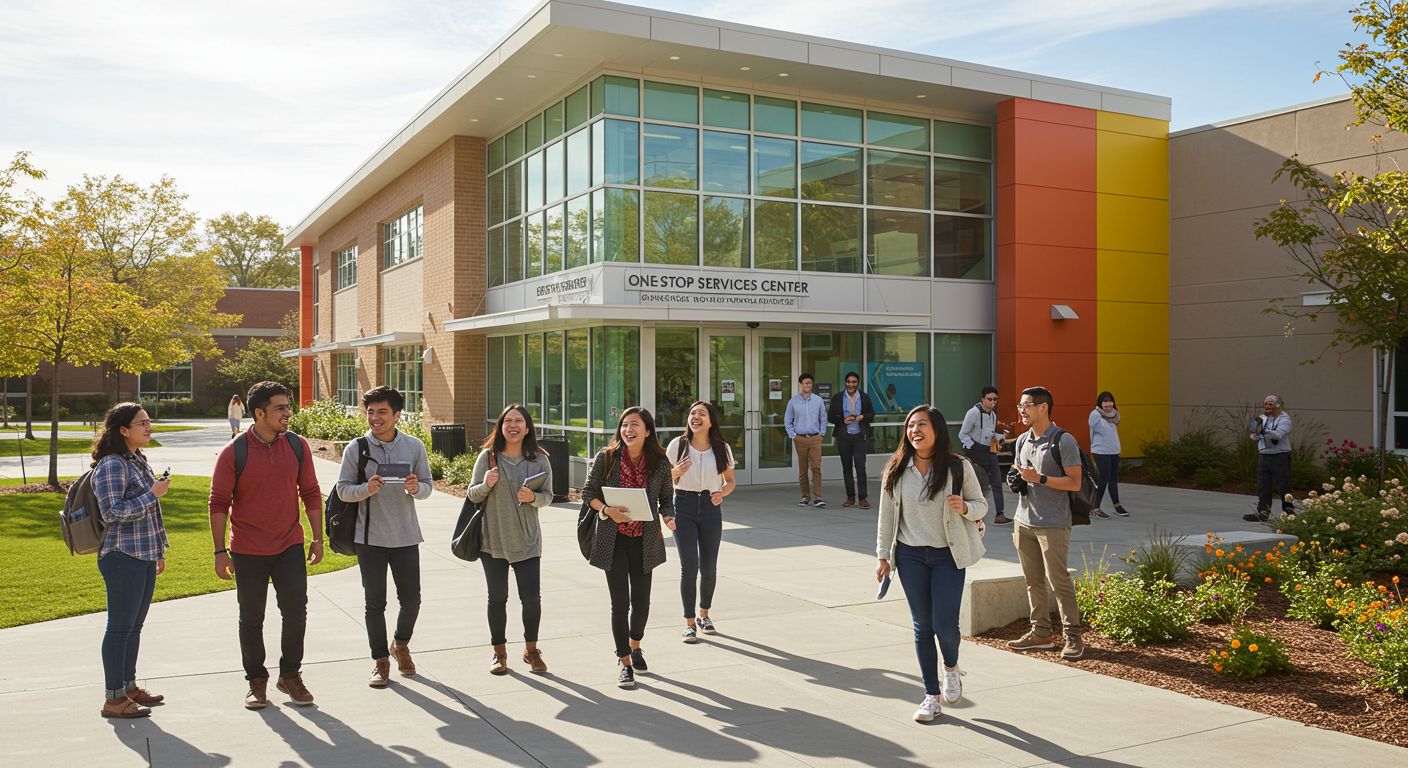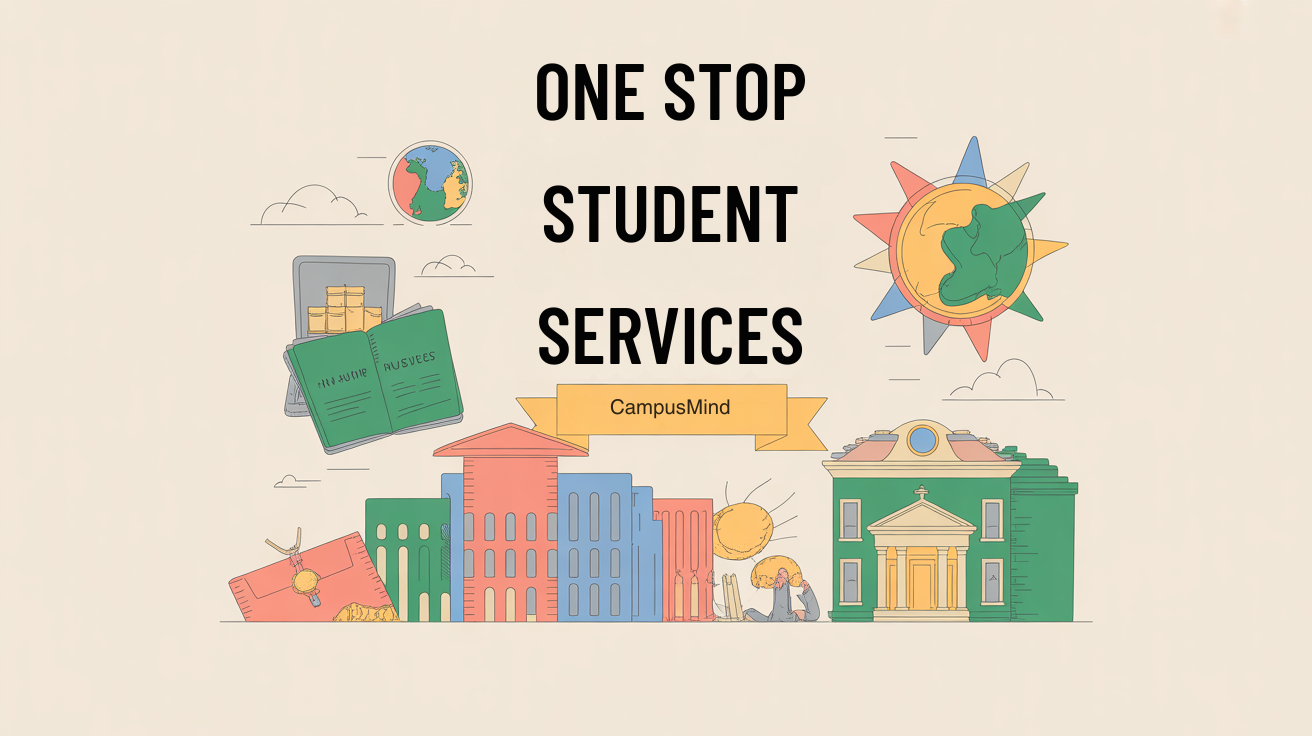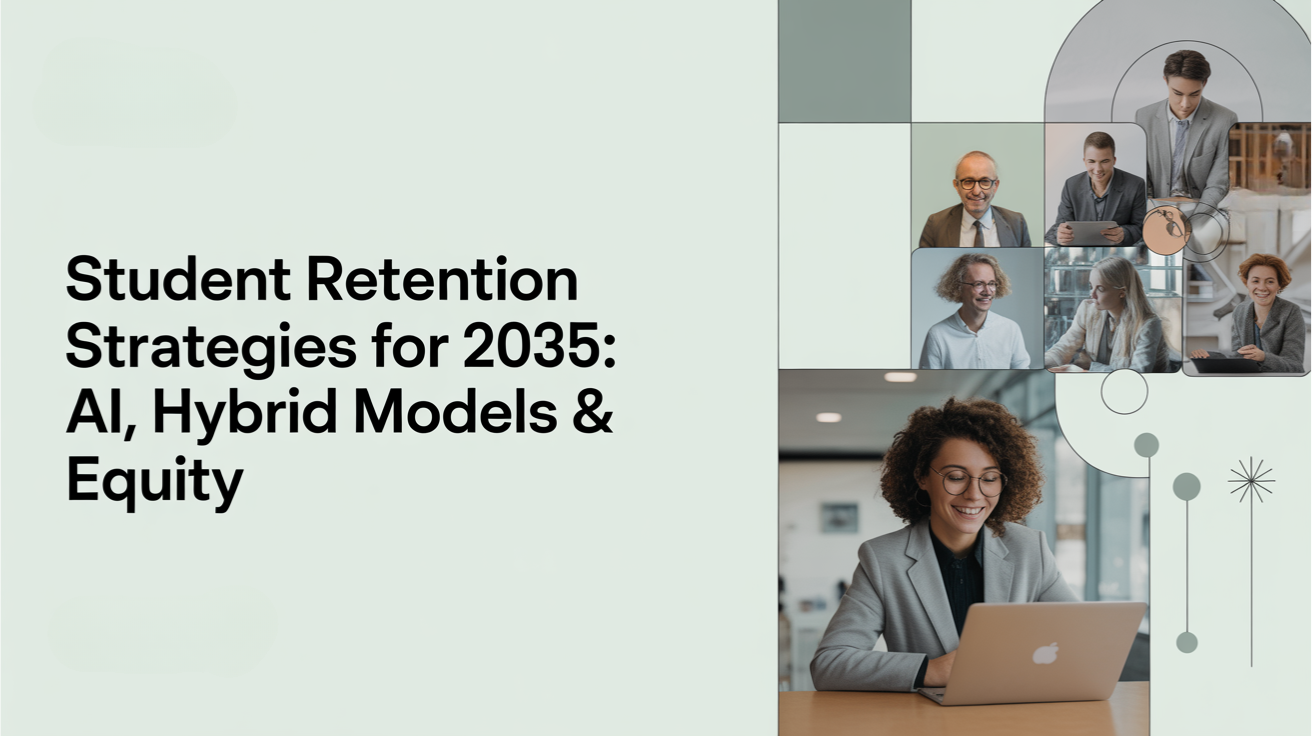TL:DR
One stop student services consolidate key administrative offices—such as financial aid, registration, advising, and billing—into a unified physical or digital hub. This model reduces administrative barriers, improves student satisfaction, and supports retention by providing accessible, coordinated support. Institutions implementing one stop student services report enhanced service delivery and measurable improvements in student outcomes.
The Hidden Cost of Fragmented Student Services
Students shouldn't need a campus map and three different office visits just to resolve a financial aid question. Yet across American colleges, fragmented administrative structures create exactly these kinds of barriers. When a first-generation student gets bounced between the registrar, the bursar, and financial aid—only to discover each office claims the other has jurisdiction—frustration mounts. For some students, these administrative headaches become the final straw that leads them to withdraw.
The structural problem runs deeper than inconvenience. Research shows that decentralized bureaucratic models designed a century ago are fundamentally mismatched to today's students [1]. When services operate in silos, students face cumulative frustrations that can contribute to decisions to leave college entirely. Administrative barriers don’t just annoy students; they actively undermine retention goals that campus leaders prioritize—another core issue one stop student services aim to solve.
What One Stop Student Services Actually Means
A one stop student services model consolidates essential administrative functions into a single, coordinated access point. Rather than requiring students to navigate multiple disconnected offices, one-stop centers bring together services like financial aid, registration, billing, academic advising, and student accounts under one umbrella.
The approach emerged in higher education during the 1990s as institutions recognized that students were struggling to navigate increasingly complex bureaucracies [2]. Today's one-stop models take multiple forms: physical centers where co-located staff provide integrated support, virtual hubs offering online self-service tools, or hybrid combinations that serve both on-campus and remote learners.
Successful one stop student services incorporate three defining elements:
Cross-trained staff who can address multiple service areas rather than sending students elsewhere. At the University of San Diego's One Stop Center, staff members receive training across financial aid, registration, and student accounts, enabling them to provide comprehensive assistance during a single visit [3].
Integrated technology systems that break down data silos. When information flows seamlessly between formerly separate offices, staff can access complete student records and resolve complex issues efficiently.
Unified governance structures that align policies and procedures across service areas. This coordination ensures consistent communication and eliminates the contradictory guidance that frustrates students when offices operate independently.
The Evidence: How One-Stop Models Improve Student Outcomes

The impact of one stop student services extends beyond student convenience—measurable outcomes demonstrate real benefits for institutions and their students.
The University of Tennessee, Knoxville provides compelling data from their One Stop implementation. In their first year, the center handled over 230,000 service requests through phone, email, and walk-in channels. Student satisfaction surveys showed scores of 90 percent or higher for professionalism, courtesy, and effectiveness [4]. Perhaps most striking: the institution recovered approximately 20 percent of frontline staff time that was previously idle during slow periods, redirecting this capacity toward proactive retention initiatives.
Research comparing institutions with and without one-stop services reveals broader patterns. A survey conducted by Inside Higher Ed and College Pulse found that 35 percent of students at colleges with one-stop shops report that staff across campus seem very happy to be doing their work [5]. This perception of institutional effectiveness matters—students who view their college as well-organized and responsive are more likely to persist through challenges.
Student satisfaction with critical services improves measurably when one-stop models are implemented. The same research found higher satisfaction levels with course registration and financial aid office interactions at institutions operating one-stop centers [6]. When students can resolve complex multi-office issues through a single point of contact, their perception of institutional effectiveness increases significantly.
Why 2025 Makes One-Stop Models More Critical Than Ever
Current budget realities in higher education amplify the importance of efficient service delivery. The 2025-26 fiscal year brings significant financial constraints: California's CSU and UC systems face ongoing base reductions totaling nearly $800 million as non-Proposition 98 state funding shrinks [7]. Across the country, institutions are implementing layoffs and program cuts as they navigate federal funding uncertainty, inflation pressures, and demographic shifts [8].
When resources tighten, institutions often face pressure to cut student services—exactly when students need support most. The paradox creates a dangerous cycle: reduced services lead to lower satisfaction and retention, which further strains institutional finances.
One-stop models offer a strategic response to this challenge. By consolidating services and cross-training staff, institutions can maintain or improve service quality while operating more efficiently. The University of Alberta's Student Connect office, for example, grew from six to thirteen generalist advisors who each handle a broad range of services, achieving better coverage than the previous fragmented model with more specialized but less flexible staff [9].
Financial pressures also highlight another advantage: one-stop services help institutions reduce costly administrative withdrawals. When students can't navigate bureaucratic barriers to resolve issues—missing paperwork, confusing holds on registration, conflicting information from different offices—some simply give up and leave. Each departure represents lost tuition revenue and failure to fulfill the institution's mission.
Implementing One-Stop Services: A Practical Roadmap
Adopting one stop student services requires careful planning across culture, systems, and staffing:
Phase One: Assessment and Planning (3-6 months)
Begin by mapping the current student service experience. Where do students encounter friction? Which processes require visits to multiple offices? Student focus groups and service request data reveal pain points that integrated services should address.
Secure buy-in across the institution. One-stop models fundamentally change how services operate, impacting multiple departments and stakeholders. Involving students, staff, faculty, and leadership from the start builds the shared commitment necessary for success [10]. Establish a cross-functional implementation team that includes representatives from each affected area.
Phase Two: Infrastructure Development (6-12 months)
Invest in integrated technology that connects previously separate systems. Staff need unified access to student records across financial aid, registration, advising, and billing. Without this foundation, "one-stop" becomes a physical location that still operates through disconnected back-end processes.
Design comprehensive training programs for staff who will become generalists. The University of Alberta found that intensive onboarding enables advisors to serve students effectively across a broad range of services, though institutions should plan for 12-18 months until staff reach full proficiency [11].
Develop clear service standards and escalation protocols. Define which issues generalist staff can resolve immediately versus those requiring specialist intervention. Create pathways for complex cases to reach the appropriate expertise without returning students to the old office-hopping experience.
Phase Three: Launch and Continuous Improvement (Ongoing)
Implement the "Plan, Do, Check, Act" evaluation cycle. The University of Alberta's experience shows that new service models typically require about two years to operate efficiently and predictably [12]. Build flexibility into operations and expect to make adjustments based on real-world performance.
Monitor key metrics from the start: service request volume and type, resolution times, customer satisfaction scores, and staff utilization patterns. These indicators reveal whether the model delivers expected benefits and where refinements are needed.
Address staff retention proactively. Generalist roles can become routine after 12-18 months, creating retention risk after institutions invest in extensive training. Develop special projects and growth opportunities that keep experienced advisors challenged and engaged [13].
Navigating Common Implementation Challenges

Real-world experience reveals challenges that institutions should anticipate and plan to address.
Change management resistance: Longtime staff in specialized roles may view cross-training as devaluing their expertise. Emphasize that one-stop models elevate rather than diminish specialized knowledge—generalists handle routine inquiries while complex cases still require specialist expertise. Frame the change as improving both staff effectiveness and student outcomes.
Technology integration complexity: Legacy systems often weren't designed to share data across organizational boundaries. Budget for both technical integration work and the change management required when staff must adopt new workflows. Some institutions phase technology integration, starting with the most critical data connections and expanding over time.
Resource constraints during transition: One-stop implementation requires upfront investment in training and technology when budgets are already tight. However, efficiency gains typically emerge within two years, and the alternative—maintaining inefficient fragmented services—costs more long-term in both finances and lost students.
Balancing efficiency with personalization: Students appreciate one-stop convenience but also value relationships with staff who understand their specific situations. Successful models incorporate caseload assignments or consistent advisor relationships alongside the flexibility to get help from any available staff member for routine transactions.
Measuring Success: Key Performance Indicators
How do institutions know whether their one-stop model delivers value? Track these indicators to assess impact and guide continuous improvement.
Service utilization patterns: Compare total service requests handled, channel distribution (in-person, phone, email, online self-service), and request resolution rates. Tennessee's One Stop handled 230,000 requests with 90 percent resolved through phone and email channels [14], demonstrating accessibility beyond traditional walk-in service.
Student satisfaction metrics: Regular surveys measuring satisfaction with specific service interactions and overall perception of institutional effectiveness. Target satisfaction scores of 90 percent or higher for key dimensions like professionalism, responsiveness, and problem resolution.
Operational efficiency: Monitor average handling time for service requests, staff utilization rates, and the percentage of issues resolved without escalation. Effective models show improved staff productivity while maintaining or enhancing service quality.
Student success outcomes: Track retention rates, time to degree completion, and administrative withdrawal rates. While many factors influence these outcomes, integrated services should contribute to measurable improvements as students encounter fewer administrative barriers.
Staff engagement and retention: Assess staff satisfaction, turnover rates, and professional development participation. The best one-stop models create engaging generalist roles that retain experienced staff long enough to realize return on training investments.
Looking Forward: The Future of Integrated Student Services
The most innovative institutions are taking one-stop models beyond physical consolidation toward truly integrated student support ecosystems. Digital one-stop portals that aggregate services across student accounts, course registration, and financial aid represent the next evolution, meeting students where they already spend time—on mobile devices.
Wichita State University's Shocker Success Center, bringing together 17 different student-focused offices, exemplifies the expanding scope of integration beyond traditional enrollment services into comprehensive student support [15]. Future models will increasingly incorporate academic advising, career services, counseling, and basic needs support into unified access points.
As institutions navigate the 2025 budget environment, one-stop student services represent strategic investment rather than optional enhancement. The model addresses multiple institutional priorities simultaneously: improving student satisfaction and retention, operating more efficiently with constrained resources, and demonstrating responsiveness to student needs.
Campus leaders should recognize that fragmented service structures actively undermine the retention goals that every institution prioritizes. When students face unnecessary administrative barriers, some will overcome them through persistence—but others will not. In an era when every enrolled student matters more than ever, institutions cannot afford to lose students to preventable bureaucratic frustrations.
The path forward is clear: consolidate services, integrate technology, train generalist staff, and create the seamless support experiences that today's students need and deserve. For colleges committed to student success, one-stop services aren't just about convenience—they're about removing the hidden barriers that stand between students and degree completion.
Works Cited
[1] Bass, Scott A. "Administratively Adrift: Overcoming Institutional Barriers for College Student Success." American University School of Public Affairs. https://www.american.edu/spa/news/administratively-adrift.cfm. Published: June 9, 2022. Accessed: October 24, 2025.
[2] Altieri, Lauren. "Modern one-stop student service centers transform the student experience." Ellucian. https://www.ellucian.com/blog/modern-one-stop-student-service-centers-transform-student-experience. Accessed: October 24, 2025.
[3] "Student Service One-Stop Shops." EAB. https://eab.com/resources/research-report/student-service-one-stop-shops/. Published: January 7, 2024. Accessed: October 24, 2025.
[4] Curry, Darren. "Implementing a One-Stop Student Services Center at Your University." Ellucian. https://www.ellucian.com/blog/implementing-one-stop-student-services-center. Accessed: October 24, 2025.
[5] Supiano, Beckie. "Service-Oriented Culture at Colleges With One-Stop Shops." Inside Higher Ed. https://www.insidehighered.com/news/2022/09/21/students-get-better-service-colleges-one-stops-infographic. Accessed: October 24, 2025.
[6] Ezarik, Melissa. "Why Your 'One-Stop' Is Worth More Than You Think." Inside Higher Ed. https://www.insidehighered.com/news/2023/02/27/consolidating-touch-points-retention. Accessed: October 24, 2025.
[7] "The 2025-26 Budget: Higher Education Overview." California Legislative Analyst's Office. https://lao.ca.gov/Publications/Report/4957. Accessed: October 24, 2025.
[8] Moody, Josh. "Trump 2.0 brings layoffs and budget cuts at 8 major colleges." Higher Ed Dive. https://www.highereddive.com/news/colleges-layoffs-budget-reductions-july-2025/752856/. Published: July 17, 2025. Accessed: October 24, 2025.
[9] "One Stop: How One Institution Transitioned to a High-Performing Student Services Model." Academic Impressions. https://www.academicimpressions.com/one-stop-high-performing-student-services-model/. Published: February 17, 2025. Accessed: October 24, 2025.
[10] Curry, Darren. "Implementing a One-Stop Student Services Center at Your University." Ellucian. https://www.ellucian.com/blog/implementing-one-stop-student-services-center. Accessed: October 24, 2025.
[11] "One Stop: How One Institution Transitioned to a High-Performing Student Services Model." Academic Impressions. https://www.academicimpressions.com/one-stop-high-performing-student-services-model/. Published: February 17, 2025. Accessed: October 24, 2025.
[12] "One Stop: How One Institution Transitioned to a High-Performing Student Services Model." Academic Impressions. https://www.academicimpressions.com/one-stop-high-performing-student-services-model/. Published: February 17, 2025. Accessed: October 24, 2025.
[13] "One Stop: How One Institution Transitioned to a High-Performing Student Services Model." Academic Impressions. https://www.academicimpressions.com/one-stop-high-performing-student-services-model/. Published: February 17, 2025. Accessed: October 24, 2025.
[14] Curry, Darren. "Implementing a One-Stop Student Services Center at Your University." Ellucian. https://www.ellucian.com/blog/implementing-one-stop-student-services-center. Accessed: October 24, 2025.
[15] Ezarik, Melissa. "Why Your 'One-Stop' Is Worth More Than You Think." Inside Higher Ed. https://www.insidehighered.com/news/2023/02/27/consolidating-touch-points-retention. Accessed: October 24, 2025.
People Also Ask:
Q1: What are the main benefits of one-stop student services for colleges?
One-stop student services deliver measurable benefits including improved student satisfaction (often 90% or higher), increased operational efficiency through better staff utilization, reduced administrative withdrawals that harm retention, and enhanced data integration that enables proactive student support. Institutions like the University of Tennessee recovered 20% of previously idle staff time while handling over 230,000 service requests annually. Budget-conscious institutions particularly value how consolidated services maintain quality while reducing operational complexity.
Q2: How long does it take to implement a one-stop student services model?
Successful implementation typically requires 18-24 months from planning through stabilization. The University of Alberta's experience shows about 2 years before new service models operate efficiently and predictably. The process involves 3-6 months for assessment and planning, 6-12 months for infrastructure development including technology integration and staff training, followed by an ongoing launch and improvement phase. Institutions should plan for iterative adjustments rather than expecting immediate perfection.
Q3: What technology is needed for effective one-stop student services?
Effective one-stop services require integrated technology that connects previously siloed systems across financial aid, registration, advising, billing, and student accounts. Staff need unified access to comprehensive student records without switching between multiple disconnected applications. Many institutions implement customer relationship management (CRM) systems, case management platforms, and student portals that aggregate self-service options. The technology investment should support both physical one-stop locations and digital access through mobile-responsive interfaces that meet students where they already engage.
Q4: How do one-stop services impact student retention rates?
One-stop services support retention by removing administrative barriers that frustrate students and contribute to withdrawal decisions. Research shows students at colleges with one-stop models report higher satisfaction with critical services like financial aid and course registration. When students can resolve complex multi-office issues through single points of contact rather than navigating bureaucratic mazes, they're less likely to become demoralized and leave. Combined with data integration that enables early intervention for at-risk students, one-stop models become strategic retention tools during an era of enrollment pressure.
Q5: What are the biggest challenges when implementing one-stop student services?
Common implementation challenges include change management resistance from staff concerned about losing specialized roles, technology integration complexity with legacy systems not designed to share data, resource constraints requiring upfront investment during tight budget periods, and balancing efficiency with personalized relationships students value. Successful institutions address these through comprehensive stakeholder engagement from the start, phased technology integration approaches, clear communication about how generalist roles enhance rather than replace specialized expertise, and intentional design that preserves continuity in student-staff relationships while offering convenient access to any available staff member for routine needs.



